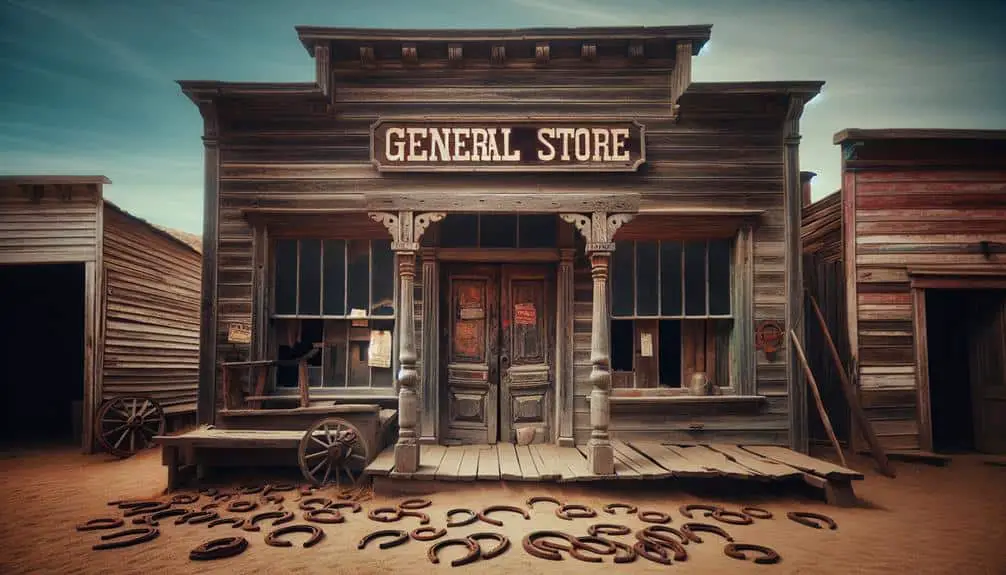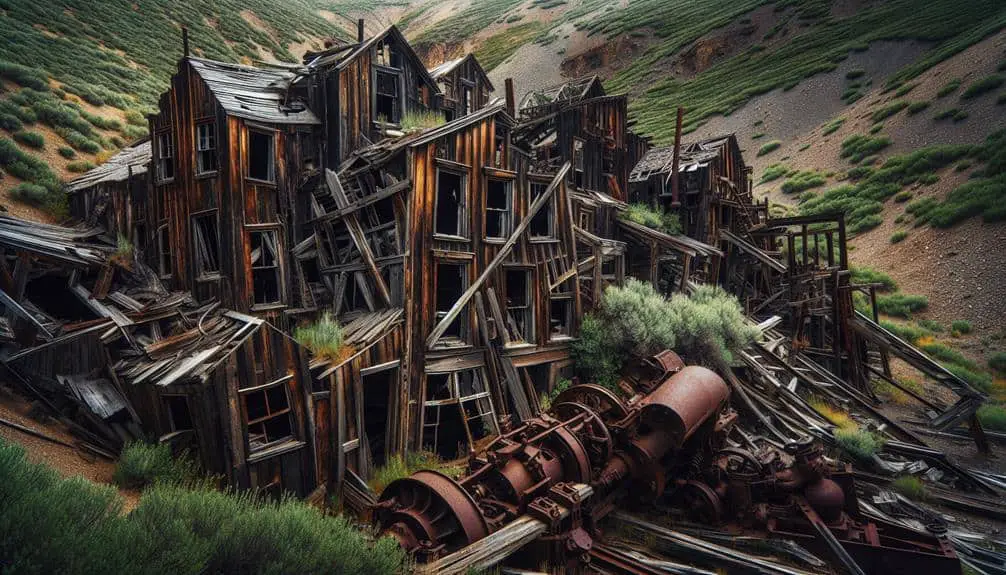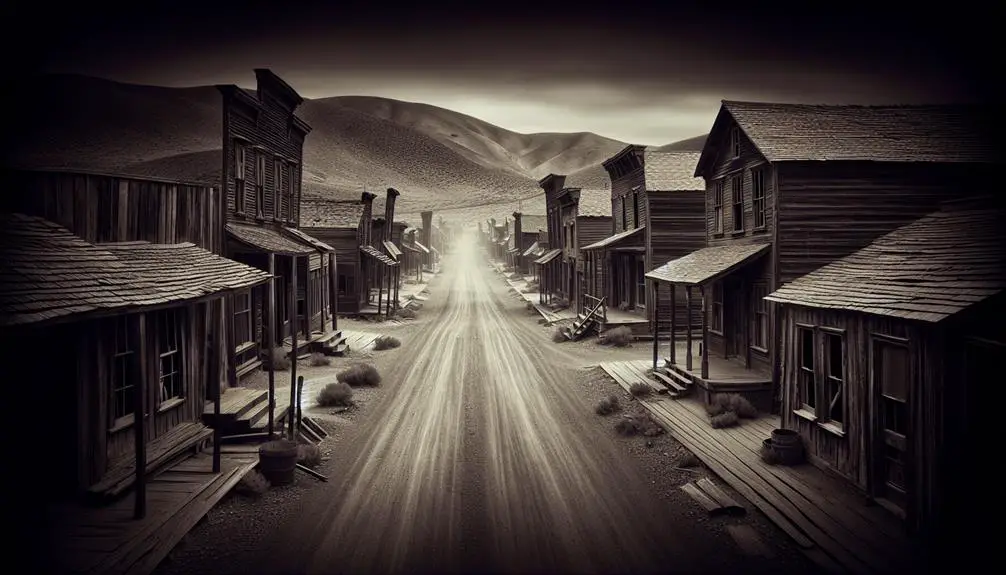In the American West, ghost towns have pioneer roots because early settlers faced tough terrain, seeking economic gains and land. Pioneers built close-knit communities along trade routes, adapting to the wilds. The Gold Rush fueled growth, leading to bustling towns that later emptied when gold ran out. Pioneer architecture was simple, with grid-like streets and key public buildings. Today, ghost towns preserve this cultural legacy, showcasing the settlers' resilience and resourcefulness. Tourism now aids in their preservation while balancing authenticity. Discover more about the pioneer spirit shaping these deserted towns.
Key Points
- Pioneer settlers established towns in the West for economic opportunities and land ownership.
- Pioneer architecture and town layout in ghost towns reflect resourcefulness and adaptation to rugged terrains.
- Ghost towns preserve cultural heritage, showcasing the resilience and ingenuity of early settlers.
- Tourism generates revenue for preservation efforts, highlighting the pioneer roots of these abandoned settlements.
- Preservation of ghost towns serves as a reminder of the pioneer legacy and the challenges they overcame in the American West.
Historical Background of Pioneer Settlements
When pioneers ventured into the vast expanses of the American West in the 19th century, they encountered a challenging landscape that tested their resilience and resourcefulness. Pioneer migration during this period was driven by a multitude of factors, including economic opportunities, the quest for land ownership, and the desire for a fresh start in a new frontier. Frontier life was harsh and demanding, requiring pioneers to adapt to rugged terrains, harsh weather conditions, and the constant threat of conflicts with indigenous peoples.
Pioneer settlements in the American West were often characterized by small, tight-knit communities that relied on each other for survival. These settlements were established along key trade routes, near valuable resources such as waterways or fertile land, and sometimes in remote areas to escape the pressures of urban life. Despite the hardships they faced, pioneers in the American West demonstrated remarkable resilience and determination in carving out a new way of life in an untamed wilderness. Their legacy continues to shape the landscape and culture of the region to this day.
Impact of Gold Rush on Ghost Towns
The influx of prospectors during the Gold Rush era greatly impacted the development and eventual decline of many ghost towns in the American West. The discovery of gold led to an economic boom in these regions, attracting thousands of fortune seekers hoping to strike it rich. As mining operations boomed, makeshift settlements quickly sprang up to accommodate the growing population. However, once the easily accessible gold deposits were depleted, the economic prosperity waned, leading to the abandonment of many towns.
The impact of the Gold Rush on ghost towns is evident in the plethora of abandoned structures that still stand today. These remnants serve as poignant reminders of a bygone era when these towns were bustling centers of activity. The economic fortunes of these towns rose and fell with the fluctuating success of mining operations, leaving behind a legacy of deserted buildings and streets.
Pioneer Architecture and Town Layout
Pioneer architecture and town layout in the American West during the Gold Rush era reflected the significant needs and rapid development of these burgeoning settlements. Pioneer buildings were characterized by their simplicity and functionality, often constructed using locally available materials such as timber and adobe. These structures were designed to withstand the harsh conditions of the frontier while providing shelter and basic amenities for the settlers.
Frontier design played a vital role in shaping the layout of pioneer towns. Streets were laid out in a grid pattern, facilitating ease of navigation and efficient use of space. Central to these towns were public buildings like churches, schools, and general stores, which served as focal points for community gatherings and activities. Residential areas were typically located on the outskirts, with homesteads spaced apart to allow for individual farming plots and livestock keeping.
The combination of practical pioneer architecture and thoughtfully planned town layouts contributed to the resilience and functionality of these early Western settlements. Today, remnants of this frontier design can still be seen in the preserved ghost towns of the American West, serving as a proof to the ingenuity and resourcefulness of the pioneers who once called these places home.
Cultural Legacy in Ghost Town Preservation
In exploring the preservation of ghost towns in the American West, one can't overlook the profound cultural legacy embedded within these historic sites. Ghost towns serve as tangible reminders of the past, reflecting the cultural heritage of the pioneers who once inhabited them. The maintenance of these towns not only safeguards physical structures but also guarantees that the stories, traditions, and values of these communities are passed down through generations.
The cultural legacy preserved in ghost towns highlights the resilience and ingenuity of the early settlers who faced numerous challenges in establishing their homes in the harsh frontier environment. Through the maintenance of these sites, modern communities can learn valuable lessons in community resilience, cooperation, and adaptation in the face of adversity.
Tourism and Preservation Efforts
Tourism plays a significant role in the ongoing preservation efforts of ghost towns in the American West. As these towns attract visitors seeking a glimpse into the past, the revenue generated from tourism often funds essential restoration projects. The delicate balance between catering to tourists and preserving the historical integrity of these sites is a challenge faced by many preservationists.
Tourism development can bring new life to these once-forgotten towns, but it also poses a risk of commercialization and overdevelopment. Striking a balance between attracting visitors and maintaining the authenticity of these historic sites is important. Many ghost towns have implemented strict guidelines and regulations to ensure that tourism activities don't compromise the integrity of the original structures.
Historic preservation efforts rely heavily on public interest and engagement, making tourism a crucial component in safeguarding these pieces of Western history for future generations. By promoting responsible tourism practices and fostering a deeper understanding of the significance of these ghost towns, we can safeguard their survival for years to come.
Frequently Asked Questions
How Did the Pioneers in the West Deal With Harsh Weather Conditions and Natural Disasters?
You faced brutal weather and disasters out West. Pioneers showed resilience. Survival strategies included sturdy shelters, food preservation, and community support. Pioneer innovations like storm cellars and fire-resistant materials helped you conquer nature's fury.
Were There Any Famous Outlaws or Lawmen Who Played a Significant Role in the History of Ghost Towns?
When exploring the history of famous outlaws and lawmen in the Wild West, you'll uncover tales of frontier justice and legendary figures who left lasting marks on the landscape, contributing to the lore of ghost towns.
What Impact Did the Railroad Have on the Development and Decline of Ghost Towns in the West?
The impact of technology and economic factors like the railroad transformed the landscape of ghost towns in the West. Railroads brought prosperity but also contributed to their decline as industries shifted.
How Did Native American Tribes Interact With the Pioneers and Settlers in the West?
In the West, Native American relations with pioneers and settlers involved complex interactions, including trade, conflict, and cultural exchange. These exchanges shaped the region's history, influencing social dynamics and the formation of communities.
Are There Any Supernatural or Paranormal Stories Associated With Ghost Towns in the West?
You've likely heard eerie tales of supernatural encounters in the ghost towns of the West. Haunted legends abound, adding mystery to these abandoned settlements. Such stories captivate those intrigued by the unknown and unexplained.



